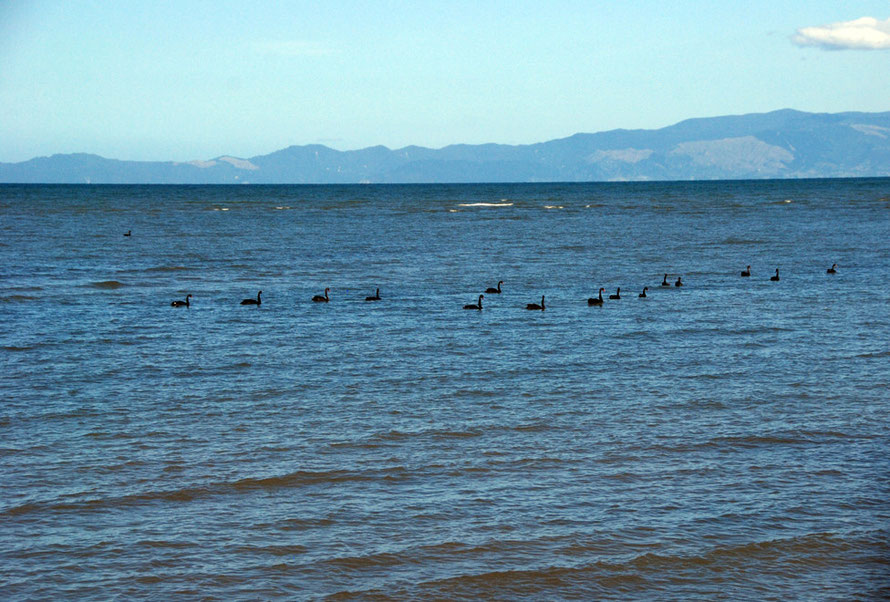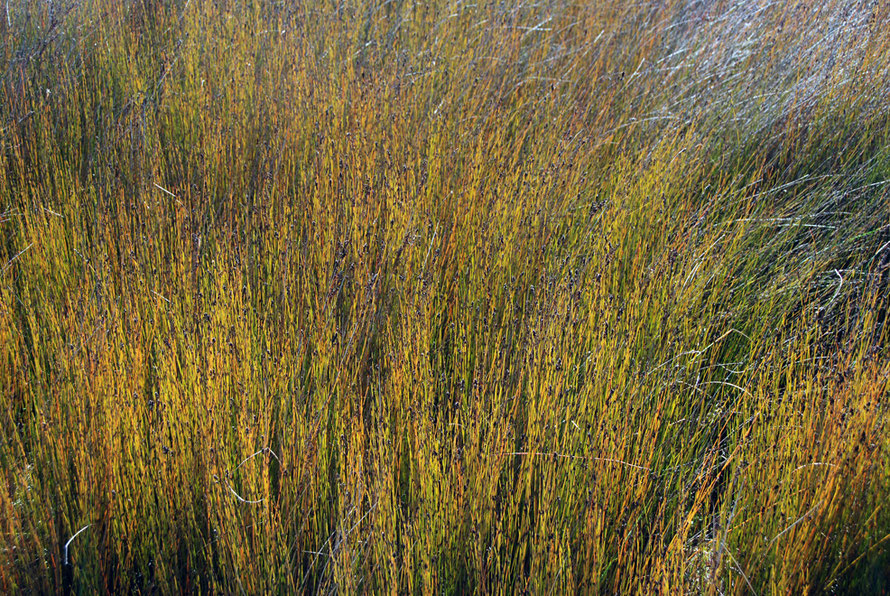Golden Bay III: Mangakarau Swamp
We continued up the coast across the lush dairyland of the Aorere valley and then turned north east up the narrow strip between the Burnett Range and placid waters of Golden Bay. Hundreds of Black Swans (Cygnus atratus) floated along in long flung out lines.
We turned off before Farewell Spit onto the gravel road to Mangakarau and the Whanganui (Westhaven) Inlet.
Later in the day we stopped and had an excellent holiday argument in the cafe overlooking Farewell Spit.
Access to the spit is through organised tours and we didn't have the time to be driven out over the 32km of sand to see seals and the gannet colony at the end. Maybe that's for another time.
I had some fish cakes in the cafe with the stony silence soundtrack after the eruption. Later all the tension dissolved with the frolicking of the innocenter-than-innocent fur seal pups at Wharariki Beach.

It's a long and winding gravel road out to Mangakarau. The road edges the east side of the Whanganui Inlet crossing bay after bay on gravel causeways that poke above the high tide. Forest cloaks the low hills and nudge the water's edge.
The inlet itself is a flooded river system - a ria - and deeply indented. The 'Dry Road' follows serpentine curves in the forest and has just enough traffic to make life interesting.
I love New Zealand's gravel roads and although slow they are generally well-graded and free of rental-car-destroying potholes.
We drove up a spur road that took us high into the hills to a tiny car park at the start of a trail. There was an 'Intentions Book' under a lean-to for trampers to leave details of their routes.
It was very empty country of steep, narrow valleys choked with regenerating bush and forest. The tree line only gives out at 300 to 700m and it would be very easy to become hopelessly lost.
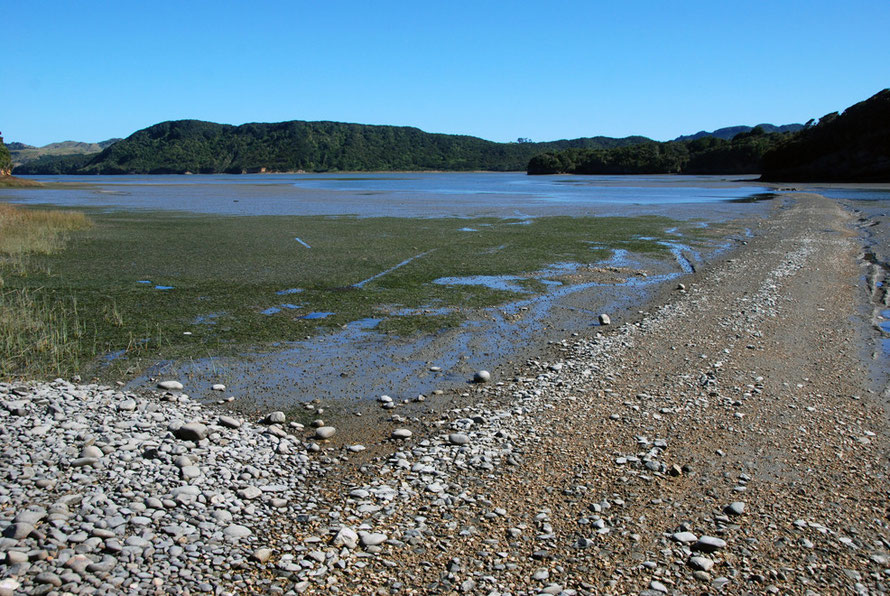
Before the engineering of the 'dry road' (as it is still called) via many causeways access to Mangakarau was by tidal roads around the edge of the inlet. Timing was crucial and local farmers driving cattle at the start of a seven-day drove to the nearest abattoir would time their journeys with spring tides and full moons.
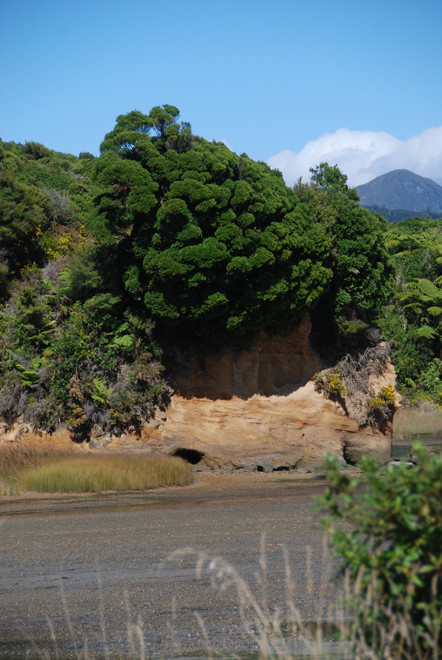
Once more the paradoxes of New Zealand featured brightly on the drive. In such amazing country with large tidal flats you would expect to see thousands of birds either feeding or floating around. But both going in and out from Mangarakau we hardly saw a bird - no ducks, no waders, not even the relatively ubiquitous white-faced heron nor the Paradise Shellduck; no shags, no Black Swans, nothing. It was truly remarkable.
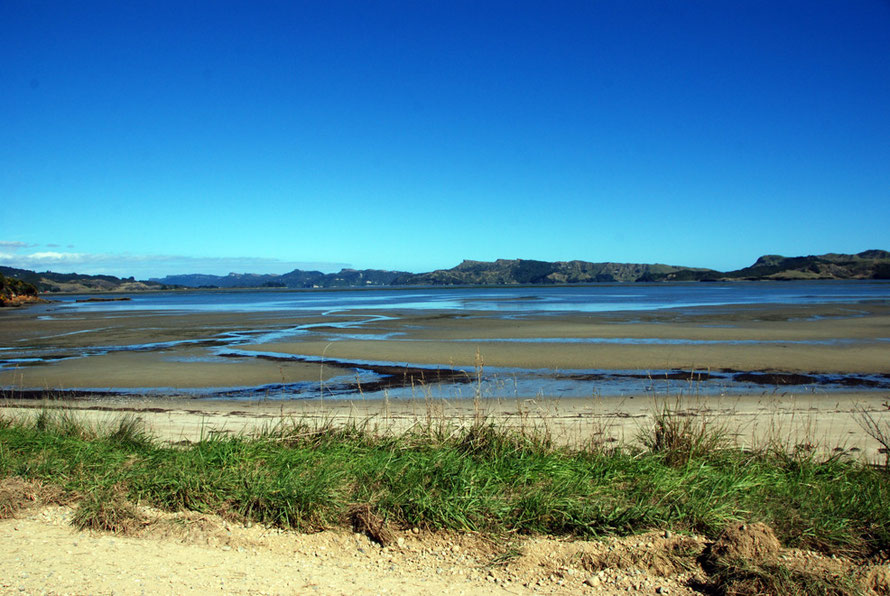
On the way in the tide was out. On the way out it was in. So to speak. We crossed bay after bay on causeways that plunged across sandflats one way and a green sea that lapped at their tops on the other.

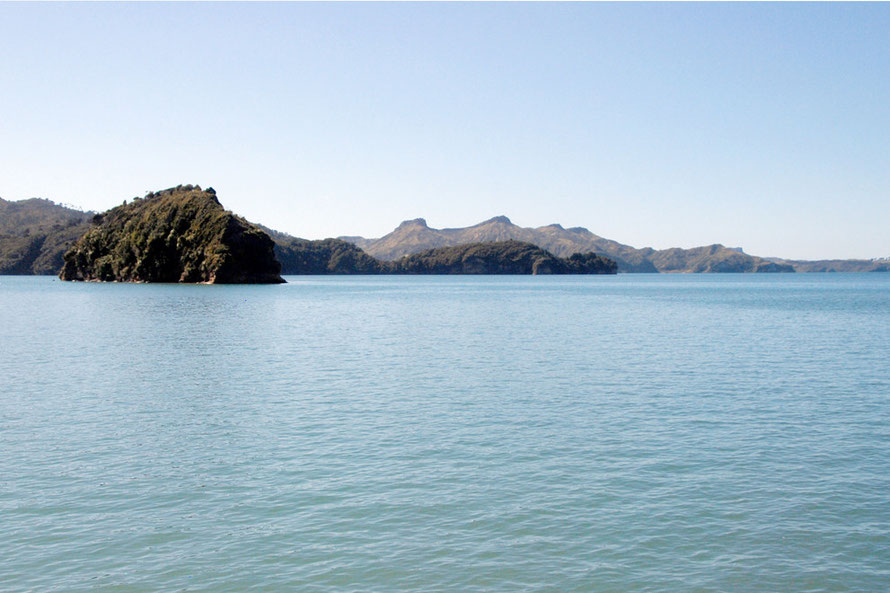
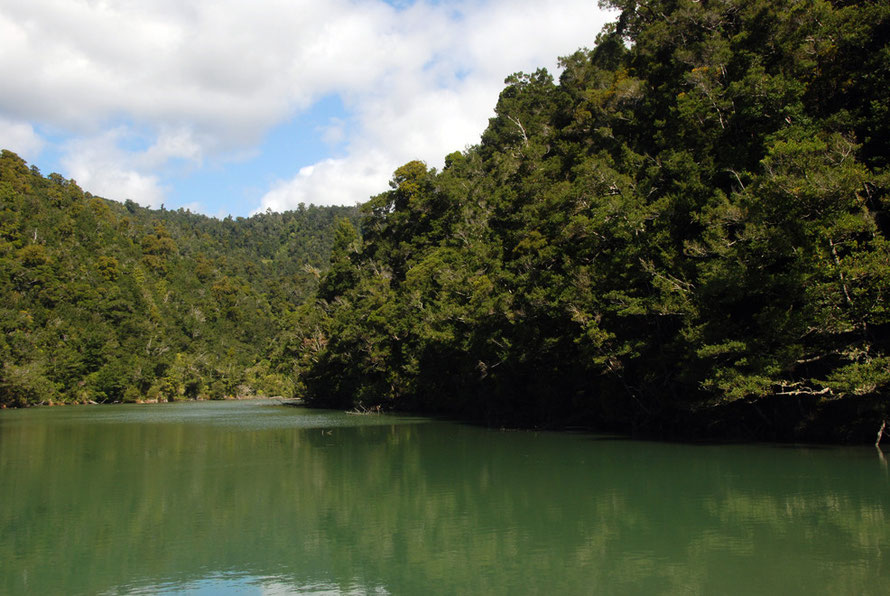
The one bird that did catch my eye was the very common Australasian/Swamp Harrier scanning the forests. Later beyond Mangakarau we saw one fly into the dry sheep paddocks and land.
They are pretty much everywhere and very attractive birds that lose their exotic appeal by being so common.


We pulled up at a turnoff having re-found our companions who had stretched out in front as I insisted on stopping to take more photos. It was hot now and the air was still.
We found the Visitor Centre for the swamp and chanced upon a large and very dead weta on the top of the gate into the centre.
This was probably a male West Coast bush weta (Hemideina broughii), one of New Zealand's tree
wetas. It was male because it did not have the 'sting' possessed by the females which is, in fact, an ovipositor or egg-laying tube.

The weta is endemic to New Zealand and there are 70 species in the families Anostostomatidae and Rhaphidophoridae.
They are in the main flightless insects that look like a grasshopper except that their hind legs are enlarged and usually very spiny.
By insect standards weta are large and the giant Poor Knight's Weta (Deinacrida fallai) - can reach an overall length of 200mm (8 in). Other weta have tusks and are truly bizarre.
Weta are nocturnal and have various diets. Most weta are predators or omnivores preying on other invertebrates, but the tree and giant weta eat mostly lichens, leaves, flowers, seed-heads and fruit.
The weta occurs in a wide variety of environments in New Zealand from the coast and up into the Southern Alps. Six giant weta and one tree weta live in the alpine zone. The weta can stand being frozen solid and yet can get up and walk away after thawing out, being blessed with a body-fluid chemistry that allows the freezing to occur without death (see Gibbs Ghosts of Gondwana pp.129-30).
Weta can deliver a painful bite and their back legs are equipped with sharp spines which they use to attack the eyes of predators.
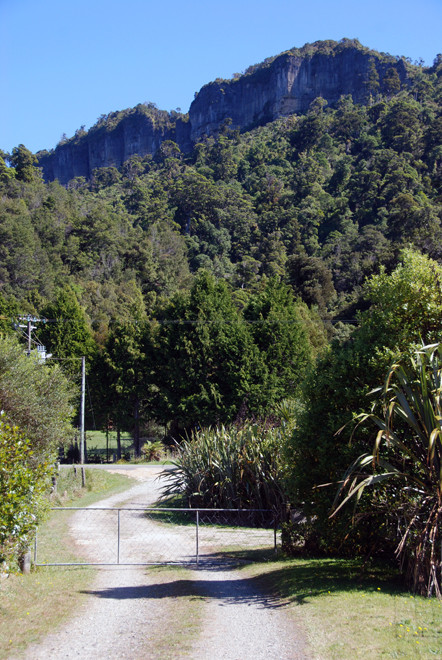
Tree weta share space in tree tunnels and the males set to fighting with their enlarged mouths and jaws hoping to repel other males and attract females to their snug harems. Lowland tree weta live for six to ten months while their Alpine cousins live longer, although some of that 'living' is done while frozen solid.
Weta are thought to originate from the Gondwana supercontinent and fossils have been found in Australia. However, after separation some 80 million years ago the New Zealand members of the broad grasshopper/cricket family have evolved to their own beautiful weta-ish uniqueness.
In the mid-day heat we proceeded to walk around the swamp paths. We appeared to be the only visitors and I was reminded of a long-ago and distant visit to the sweltering Bontibok Nature Reserve in the Western Cape in South Africa (see here). However, the heat was nothing like South Africa.
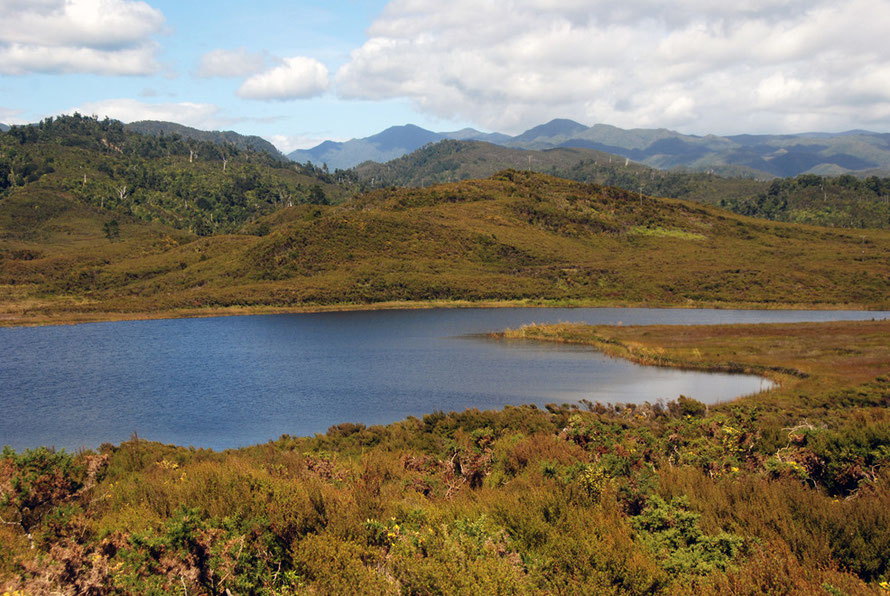
I had hoped we might get up close with the swamp but we were either walking along boggy roadways surrounded by reeds or on dry paths through unappealling gorse and manuka scrub.
Given that I had dragged the entire party out to this godforsaken spot I was hoping for some avian action or something to make the swamp more appealing than the delightful and cool Penguin bar and restaurant (with its visiting German rigged out in full lederhosen) near our seaside villa at Pohara. But it was not to be.
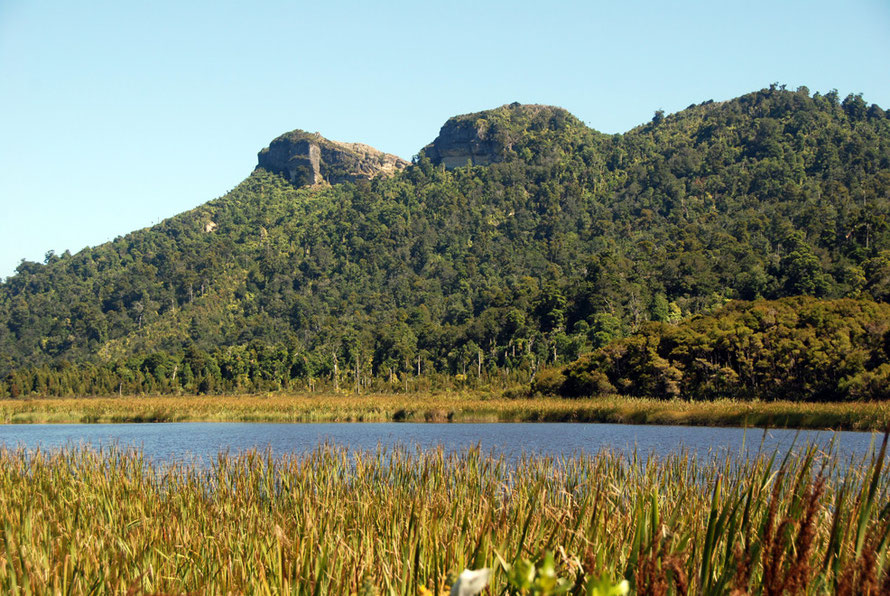
We did see a couple of distant ducks and the views of Lake Mangawakau and Big Pond with their remnant forest, reed beds and limestone bluffs and hills marching backwards into crest upon crest of unending bush.
But the hidden presence of an endemic mud fish was hardly going to impress the doubters thirsting for a glass of Speights best lager and a plate of hot, golden chips. As they say, when in one its best to stop digging but I couldn't help myself.

To me the stark white Coral Moss, the tangle fern and the creeping club moss were sort-of-wonders to behold - even if I didn't know what it was I was beholding.
The swaying siena-red seed heads of the erect swamp sedge - Gahnia rigida - were delightful and somehow full of some ancient power as was the beautiful delicate green swooniness of the kiokio ferns in deep shade.
But I had had time to acclimatise to the variety and beauty of New Zealand's biota. I was seeing difference and variation, contrast and novelty whereas 'The Principal' had been hammering out the vagaries and complexity of European environmental law with a group of MA students at Auckland University.
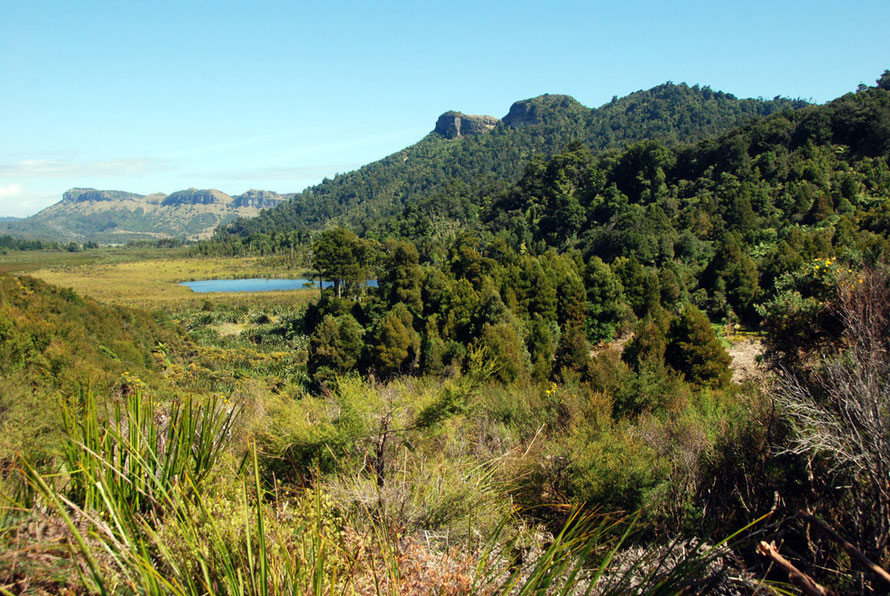
To compound matters I tarried too long in the visitor centre, desperately, and I mean desperately, trying to document as many of the informative displays and photographs that were on offer. I knew I'd never be back here and my curiosity was piqued. I needed to know more. But the hole was getting bigger.


